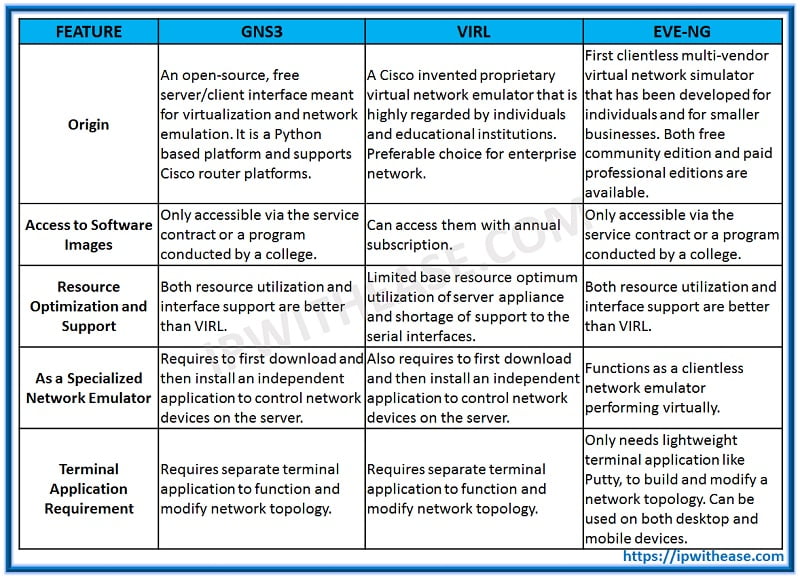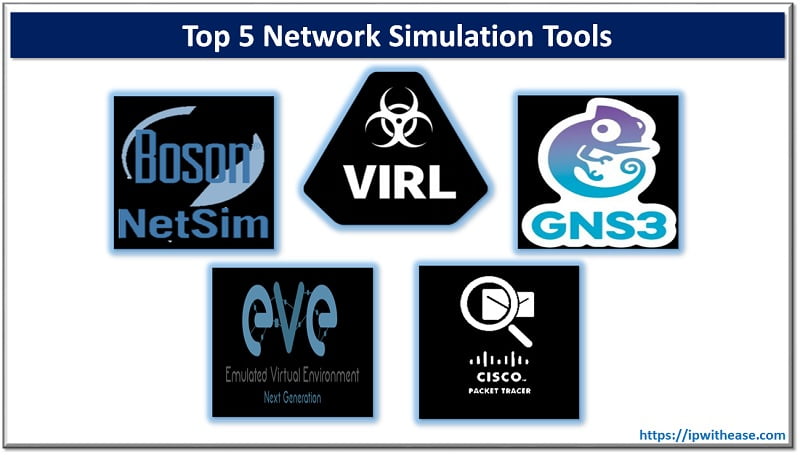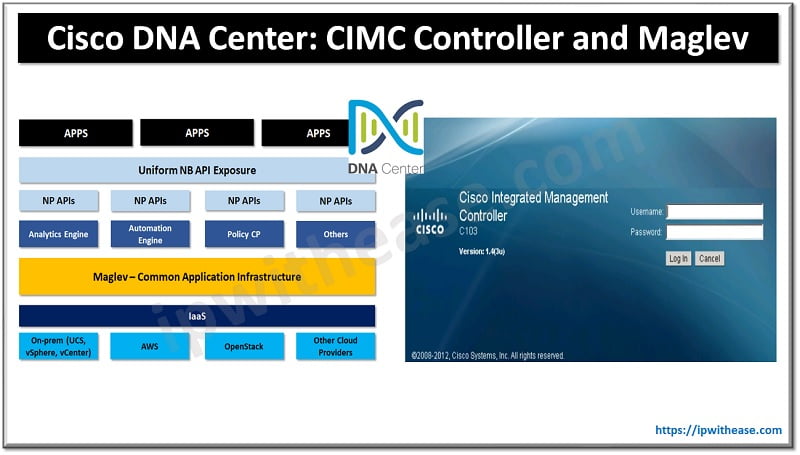Introduction to Eve-NG, GNS3 and VIRL
With the advent of the virtual network devices, the accessibility to more advanced feature set has been realized on the fingertips. With the functions exhibited by the virtual network devices, it is easier for us to understand how the actual physical network devices are going to respond in the real world.
Now, one may ask what is the role of an emulator in this whole scheme of things? Well, an emulator is basically a piece of software that connects and runs virtual network devices in the put-together fashion.
There is a range of network emulators that one can opt for in order to access premium quality virtual network simulation. But when it comes to opting between the finest virtual simulation interfaces, then the comparison is ought to be between GNS3 vs Eve-NG vs VIRL.
Let us understand them briefly prior to drawing the lines of comparison among them-
- GNS3 or Graphical Network Simulator-3 is an open-source, free server/client interface meant for virtualization and network emulation. It is a Python-based platform and supports Cisco 1700, 2600, 2691, 3600, 3725, 3745, as well as 7200 router platforms.
- Virtual Internet Routing Lab or VIRL is a Cisco invented proprietary virtual network emulator that is highly regarded by individuals and educational institutions. It is highly effective in emulating enterprise networks.
- Emulated Virtual Environment Next Generation or EVE-NG is a form of multi-vendor virtual network simulator that has been developed for individuals and for smaller businesses. It comes in both free community edition and professional edition with a fee payable annually.
Differentiating GNS3 vs Eve-NG vs VIRL
- With the annual subscription, one can avail access to VIRL for the network device software images. With the other network emulators, these software images are only accessible via the service contract or a program conducted by a college.
- VIRL is easier and up with more features when it comes to the configuration automation while comparing it with GNS3 or EVE-NG.
- When it comes to the setbacks then VIRL faces them in the form of base resource optimum utilization of VIRL server appliance as well as the shortage of support when it comes to the serial interfaces.
Both the features are better with GNS3 and EVE-NG when compared with VIRL. - While comparing GNS3 vs EVE-NG, we find that GNS3 is a free, open-source community that has built a well-documented piece of software.
It does follow a traditional client/server application model, but the best part is that the server component is easy to configure, deploy and maintain. In the case of EVE-NG, it comes in both free community edition and professional paid edition.
One key setback with GNS3 is that you are required to source own network device software images in order to emulate.
But it is not needed to be observed as a fault because bundling software images from Cisco IOS with GNS3 would turn out to be illegal.
Similarly, EVE-NG also requires licensed access in order to get to the network device software images. - While comparing GNS3 vs Eve-NG vs VIRL on the grounds of operating as a specialized network emulator, we would find that only EVE-NG is the one which is a clientless network emulator performing virtually.
On the other hand, both VIRL and GNS3 require you to first download and then install an independent application to manipulate the functioning of network devices on the server. - Both VIRL and GNS3 require a separate terminal application to function, EVE-NG only needs a lightweight terminal application like PuTTY, in order to build and modify a network topology.
The entire process can easily be accomplished via an HTML 5 web client and it can not only be used over desktop but also on various mobile devices too!
Comparison Table : GNS3 vs VIRL vs EVE-NG
| PARAMETER | GNS3 | VIRL | EVE-NG |
|---|---|---|---|
| Origin | An open-source, free server/client interface meant for virtualization and network emulation. It is a Python based platform and supports Cisco router platforms. | A Cisco invented proprietary virtual network emulator that is highly regarded by individuals and educational institutions. Preferable choice for enterprise network. | First clientless multi-vendor virtual network simulator that has been developed for individuals and for smaller businesses. Both free community edition and paid professional editions are available. |
| Access to Software Images | Only accessible via the service contract or a program conducted by a college. | Can access them with annual subscription. | Only accessible via the service contract or a program conducted by a college. |
| Resource Optimization and Support | Both resource utilization and interface support are better than VIRL. | Limited base resource optimum utilization of server appliance and shortage of support to the serial interfaces. | Both resource utilization and interface support are better than VIRL. |
| As a Specialized Network Emulator | Requires to first download and then install an independent application to control network devices on the server. | Also requires to first download and then install an independent application to control network devices on the server. | Functions as a clientless network emulator performing virtually. |
| Terminal Application Requirement | Requires separate terminal application to function and modify network topology. | Requires separate terminal application to function and modify network topology. | Only needs lightweight terminal application like Putty, to build and modify a network topology. Can be used on both desktop and mobile devices. |
![]()
Download the difference table here.
Conclusion:
While comparing GNS3 vs Eve-NG vs VIRL, it is essential to take into account the current ecosystem of network emulation and simulation software.
The operation process related to some of this software can be a daunting task, especially for the newcomers in the networking industry. There are multiple features and characteristics associated with this software that may allure different kinds of learners.
That is the reason why we are not recommending you a particular software, but informing you about the merits and demerits of each choice, so that you could make a rational decision at your own grounds. We hope our efforts have been worthwhile!
Continue Reading:
Top 5 Network Simulation Tools
ABOUT THE AUTHOR

You can learn more about her on her linkedin profile – Rashmi Bhardwaj




